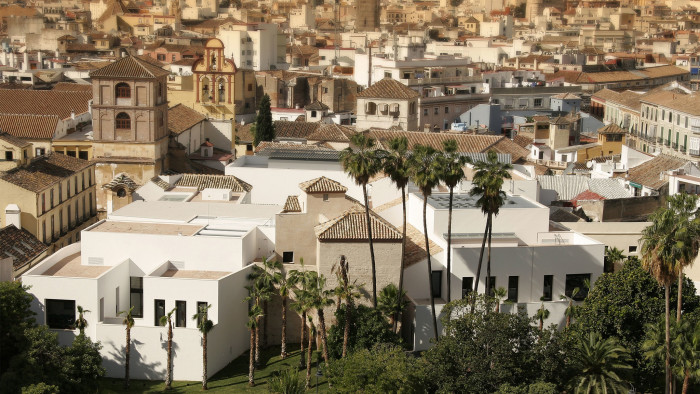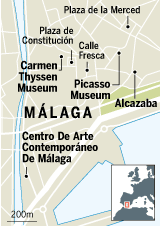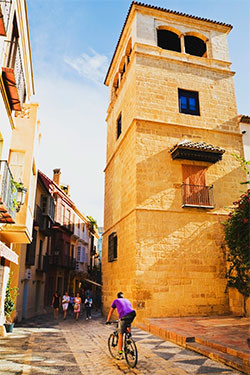Málaga’s Picasso-led transformation

Simply sign up to the Life & Arts myFT Digest -- delivered directly to your inbox.
A decade ago, I was in El Pimpi, one of Málaga’s most traditional tapas bars, talking to architect Richard Gluckman about his design for the city’s Picasso Museum, which had just opened next door. To create the museum, Gluckman had remodelled a grand 16th-century Renaissance residence, the Palacio de Buenavista, adding a new section for temporary exhibitions.
“This used to be the Jewish quarter,” he told me, “We had to demolish some houses but they were just about falling down anyway.”
Parts of Málaga were indeed very dilapidated back then – and some streets still are – but the area around the museum has undergone a dramatic transformation and the effect is rippling right through the centre.
Shortly before the museum’s 10th anniversary at the end of October, I asked its director José Lebrero Stals about its impact on the city.
“It has played a decisive role in the regeneration of the heart of Málaga and has helped the city become a tourist destination in its own right,” he told me. “The museum is really well integrated in the urban environment, rather than being imposed on it. You can have architecture that shouts from the rooftops of course, but between a shout and a well-written poem, the poem lasts longer.”
Before it opened, many tourists came to Malaga from the beach resorts of the Costa del Sol but only stayed for the day (often spending much of that at El Corte Inglés department store). Now the museum is the primary focus for many visitors, who might stay for two or three nights and who are increasingly coming in autumn or spring, when the temperature is better suited to a cultural city break than summer.
More than 3.5m people have visited the museum so far, often queueing to get in. To meet this demand, boutique hotels are opening up all over town. I was staying in the Petit Palace Plaza, a grand residence just off the Plaza de la Constitución. On a corner of the square, the hip Room Mate group has taken over the century-old Larios hotel, and a few minutes away is the five-star Vincci Posada del Patio.

In the esplanade that has been created at the rear of the museum, El Pimpi has expanded with outdoor tables and a new seafood restaurant. On a weekday lunchtime last month, the terrace was packed. Even in December and January it is often warm and sunny enough during the day to sit outside.
Picasso was born just a few minutes’ walk away in a house on Plaza de la Merced, where children still chase the pigeons, just as Picasso and his sisters used to.
“To house the museum, the family wanted a traditional building in the Málaga that Picasso knew,” said Lebrero Stals. “Our collection was donated by his family, who played a key role in bringing the museum to the city. The displays enable visitors to trace Picasso’s life from the late 19th century until his death in 1973. We don’t have the best works here, but we do have the location, which no other museum can have.”
They also have Phoenician and Roman remains, uncovered while the museum was under construction, which you can see if you go down to the basement. Gluckman had told me that, although it was a very exciting for the local archaeologists, it held up building work for a couple of years.
Remains from the different civilisations that settled in Málaga turn up all the time, regularly bringing work on the city’s metro system to a halt. Málaga’s importance in Roman times is borne out by the amphitheatre behind the museum – which is where I arranged to meet local guide Victor Garrido. “It’s not just Roman stuff down there,” he said, as I peered at the ruins. “There is part of a Phoenician wall, the foundation of a Carthaginian tower, bits of the Greek baths, and a lot more besides. The more we dig, the more we find.”
Overlooking the Mediterranean on the hill behind stands the Alcazaba, a Moorish fortress that would have been one of Picasso’s earliest memories. “This is the only place in the world you can see a Roman amphitheatre below a Moorish fortress. There is a little bit of everything in Málaga, even if it is not the best,” said Garrido, echoing what Lebrero Stals had said about the museum’s collection.

We strolled through the lanes of the centre, which are now mostly pedestrianised and lined with shops and tapas bars. Dani García, who won two Michelin stars for his restaurant Calima in Marbella, is also behind sleek gastrobar Manzanilla in Calle Fresca, known for its irresistible bull burger. Opposite, he has taken over a traditional bar to set up Wendy Gamba, where the prawns in a batter made with the local Victoria beer are another favourite.
We crossed Plaza de la Constitución and headed towards the Carmen Thyssen Museum, which focuses on 19th-century Spanish painting. Like the Picasso Museum, it is housed in a 16th-century palace and has already made quite an impact on the labyrinth of lanes around it, even though it has only been open for two years.
“This street, Andrés Pérez, was actually quite dangerous, somewhere you would avoid, but look at all the development going on now,” said Garrido. One of the oldest buildings, the palatial Casa del Cardenal, dates back to the 17th century and houses an antique shop that sprawls through grand rooms and into a cool courtyard. Owner Paco Cano, who heads the neighbourhood association, told me the shops on the street had clubbed together to have their façades cleaned. Hammam Al Ándalus, which has recreated traditional Arab baths in several Spanish cities, recently opened a branch around the corner from the Carmen Thyssen Museum. It occupies what now seems like a prime location, but just a few years ago it would have been unthinkable.
That afternoon I went to the CAC, Malaga’s contemporary art museum, which also marked its first decade this year. It, too, has been a catalyst for local regeneration. Soon after it opened, artists started moving into the grid of grungy streets east of the museum, between the port and the Alameda boulevard, attracted by low rents and large spaces.
The CAC’s dynamic director, Fernando Francés, has been spearheading the rejuvenation of the area – renamed Soho – as an edgy, arty neighbourhood. On the corner of the recently pedestrianised Tomás Heredia Boulevard, I watched as artist Dadi Dreucol got into a crane that lifted him up the side of a building. He spent the weekend creating a mural inspired by Heredia, a key figure in the industrial development of Málaga in the 19th century. This was part of MAUS (Málaga Arte Urbano Soho), which invites artists, photographers and designers to create street art and decorate the walls, windows and shutters of the area. Garrido, who lives in Soho, is already offering art tours.
Málaga’s beaches stretch for miles on either side of the port. I met up with my friend José Luis Gallardo, a screenwriter who has moved back to his native city from Madrid, and we cycled south along the promenade to La Térmica, a cultural centre that opened at the beginning of the year. The vast building that houses it is a century old and has variously been a hospital, an orphanage and a college of printing. Its name comes from a power station that used to stand next to it.
“As children, we always wanted to come to this bit of the beach as the water was warmer, because of the hot water flowing from the power station,” he said afterwards, as we sat on the beach eating ice creams. “We didn’t think about pollution back then.”
Now, only a few brick chimneys punctuate the skyline along the coast; the sole remnants of the city’s industrial heritage. As afternoon slipped into evening, tanned people wearing shorts were running, skating and cycling along the promenade. With its new museums, tapas bars, shops and waterfront development, maybe it’s time people in Málaga stopped apologising for not having the best of anything. It all looked pretty good to me.
——————————————-
Details
Annie Bennett was a guest of the airline Vueling (vueling.com) and the Hotel Petit Palace Plaza (petitpalaceplazamalaga.com; doubles from €80). Walking tours with Victor Garrido start at €15 per person (welovemalaga.com).
Culture Picasso Museum, museopicassomalaga.org; Carmen Thyssen Museum, carmenthyssenmalaga.org; Hammam Al Ándalus, hammamalandalus.com; Casa del Cardenal, lacasadelcardenal.com; La Térmica, latermicamalaga.com; CAC Contemporary Art Centre, cacmalaga.org
Food El Pimpi, elpimpi.com
Manzanilla, Calle Fresca 12
Wendy Gamba, Calle Fresca 10
For more information see malagaturismo.com and spain.info
Comments